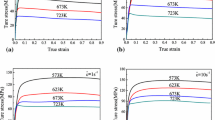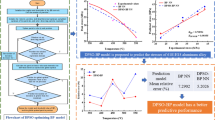Abstract
An isothermal compressive experiment using Gleeble 1500 thermal simulator was studied to acquire flow stress at different deformation temperatures, strains and strain rates. The artificial neural networks with the error back propagation(BP) algorithm was used to establish constitutive model of 2519 aluminum alloy based on the experiment data. The model results show that the systematical error is small(δ=3.3%) when the value of objective function is 0.2, the number of nodes in the hidden layer is 5 and the learning rate is 0.1. Flow stresses of the material under various thermodynamic conditions are predicted by the neural network model, and the predicted results correspond with the experimental results. A knowledge-based constitutive relation model is developed.
Similar content being viewed by others
References
Kramer L S, Blair T P, Blough S D. Stress-corrosion cracking susceptibility of various product forms of aluminum alloy 2519 [J]. Journal of Materials Engineering and Performance, 2002, 11(6): 645–650.
Devicent S M, Devletian J H, Gedon S A. Weld properties of the newly developed 2519 - T87 aluminum armor alloy [J]. Welding Journal, 1988, 67(7): 33–43.
Dymek S, Dollar M. TEM investigation of age-hardenable Al 2519 alloy subjected to stress corrosion cracking tests[J]. Materials Chemistry and Physics, 2003, 82(1): 1–3.
Lee W S, Lam H F. The deformation behavior and microstructure evolution of high strength alloy steel at high rate of strain[J]. Materials Processing Technology, 1996, 57(3–4): 233–240.
Lee W S, Lin C F. High temperature deformation behavior of Ti6Al4V alloy evaluated by high strain rate compression tests[J]. Journal of Materials Processing Technology, 1998, 75(1–3): 127–136.
Rao K P, Prased Y K. Neural network approach to flow stress evaluation in hot deformation[J]. Journal of Materials Processing Technology, 1995, 53(3–4): 552–566.
LIU Jian-tao, CHANG Hong-bing, XU Zu-yao, et al. Prediction of the flow stress of high-speed steel during hot deformation using a BP artificial neural network[J]. Journal of Materials Processing Technology, 2000, 103(2): 200–205.
Rao K P, Haobolt E B. Development of constitutive relationship using compression testing of medium carbon steel[J]. Journal of Engineering Materials and Technology, 1992, 114(1): 116–123.
ZHANG Xing-quan, PENG Ying-hong, RUAN Xue-yu. An artificial neural network model for Ti-17 alloys[J]. The Chinese Journal of Nonferrous Metals, 1999, 9(3): 590–595. (in Chinese)
Liu Z Y, Wang W D, Gao W. Prediction of the mechanical properties of hot-rolled C-Mn steels using artificial neural networks[J]. Journal of Materials Processing Technology, 1996, 57(4): 332–336.
Larkiola J, Myllykoski P, Korhonen A S. The role of neural networks in the optimization of rolling processes[J]. Journal of Materials Processing Technology, 1998, 80–81(1): 16–23.
WANG Xue-ye, QIU Guan-zhou, WAN Dian-zuo. Molten salt phase diagrams calculation using artificial neural network or pattern recognition bond parameters[J]. Trans Nonferrous Met Soc China, 1998, 8(1): 142–148.
FENG Jian-peng, GUO Ling. The application of artificial neural network model to constitutive relations of heat-resistant alloys[J]. Journal of China Mechanic Engineering, 1999, 10(1): 49–51. (in Chinese)
QI Le-hua, HOU Jun-jie. An neural network model for direct extrusion in metal solidification [J]. The Chinese Journal of Nonferrous Metals, 1999, 9(3): 586–589. (in Chinese)
CHAI Tian-ruo, XIE Shu-ming, DU Bing, et al. An artificial network model for the terminus temperature and carbon content in steel metallurgy[J]. The Chinese Journal of Nonferrous Metals, 1999, 9 (4): 868–872. (in Chinese)
Author information
Authors and Affiliations
Corresponding author
Additional information
Foundation item: Project(03-5) supported by the State Key Lab for Plastic Forming Simulation and Die Technique
Rights and permissions
About this article
Cite this article
Lin, Qq., Peng, Ds. & Zhu, Yz. Establishment of constitutive relationship model for 2519 aluminum alloy based on BP artificial neural network. J Cent. South Univ. Technol. 12, 380–384 (2005). https://doi.org/10.1007/s11771-005-0165-z
Received:
Accepted:
Published:
Issue Date:
DOI: https://doi.org/10.1007/s11771-005-0165-z




